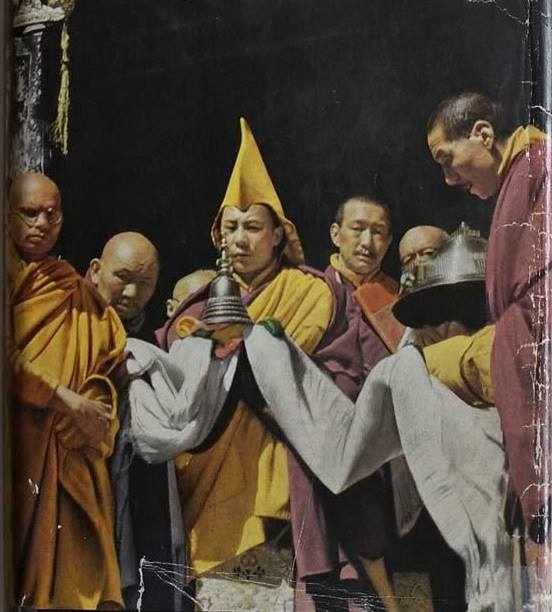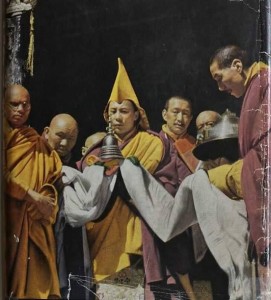His Holiness the Dalai Lama’s initial encounter and association with Dolgyal can be best described by quoting from his own talks. Therefore, the following is taken from a talk that His Holiness gave on 13th June, 1978, to an audience that included Geshe Lobsang Nyima, the erstwhile abbot of Namgyal Monastery [who later became the 100th Gaden Tripa]; Geshe Lobsang Tenzin; staff members with twenty of the senior monks of Namgyal Monastery; five senior monks from Nechung Monastery; two lecturers from the Buddhist School of Dialectics; two representatives each from Gyuto and Gyumed Tantric College from among those who lived in Dharamsala at their branches; and Rato Kyongla Rinpoche from the US and Nyagre Kelsang Yeshe, both of whom had requested and were granted special permission to sit with the audience.
[Note: His Holiness initially shared his experience on Dolgyal to only a limited number of people. In many of His Holiness’ early talks, His Holiness often referred to Dolgyal as Gyalchen, another alternative epithet for Shugden. The term ‘god’ in Buddhism means a formless being and not the ‘Almighty God’. Thus, a god can be a mundane being or a super mundane being. Dolgyal is a considered a god and is a celestial being. In the contemporary Buddhist terminology, the term deity, god and celestial being are synonymous. ‘Tantric Deity’ is a tantric term used for the Buddhas whose practices are taught in Buddhist Tantra.]
I have to confess here that I had made a mistake. If you wonder what that mistake was, then it was that I was not able to fall in line with the traditional practice adopted by the successive Dalai Lamas and maintain it. When I visited Domo, it so happened that I had to stay at Dungkar Monastery at Domo; Domo Dungkar Monastery had the practice of summoning the peaceful as well as the wrathful aspect of Gyalchen [Shugden]. Although the medium was not somebody well learned or wise, prophesies that he spelled out when in trance appeared to be quite specific and impressive. At that time, as I fled to Domo due to some immediate, unfavorable circumstances, neither of the two mediums of Nechung or Gadong [two state oracles] was present among my entourage. In those days, except inviting Nechung and Gadong for consultation during the summer and winter invocation-ceremonies, I did not become close to either of them; so, no invitation for consultation took place in my own chamber at that time. Basically, it was a time when I was just a young boy growing up. Leave aside facts about gods or deities, even on mundane subjects, I was not able to discern properly and independently. In gist, around that time I was placed in many difficult situations, of which one was trying to negotiate with the Chinese. With the absence of the two state oracles to consult on one side, and my entourage members on the other with two different opinions, one requesting me to return to Lhasa and the other persuading me to flee to India, I was confronted with many difficulties while making my decisions.
At such a time, for one, there was that [seemingly] impressive medium [of Shugden] nearby. Coupled with this was my strong faith in Je Phabongkha that prompted me to favour and become closer to Gyalchen. Another factor was Kyabje Trijang Rinpoche’s fondness for him. With all these factors into play, finally I invited the Dulzin [the peaceful aspect in monastic robe] aspect of Shugden for consultation in my chamber. When conducting the invitational ritual, they have this practice of chanting the prayer the Hundred Deities of Tushita with the secret tune of Takphu. Dressed in the yellow monastic robe with the Pandita’s hat on his head, the Dulzin Gyalchen looked impressive. Turning towards my direction, he fell onto the ground in a manner a tree would fall down flatly to offer me prostrations. When consulting him or seeking clarification, his replies seemed quite clear. Once, he even said that he had come from Tushita after having consulted Tsongkhapa, looking quite decisive and impressive while saying that. When I was about to return back to Lhasa, with my interest in the propitiation of Gyalchen [Shugden] increased, I invited the wrathful aspect of Shugden in the main monastic hall of Dungkar Monastery and offered him a new set of a king’s attire. In this way, I first came to be connected with Gyalchen [Dolgyal].
At that time, not maintaining his own discipline, the 14th Dalai Lama made the first mistake of deviating from the path of the former Dalai Lamas. After returning to Lhasa from Domo, Geshe Tsewang Samdup sent me some words of Shugden’s prophecy through Jampa Choesang, the chief chamberlain of my residence. They were very close to one another. Geshe Tsewang Samdup lived at Chaksam and was known to be quite close to the medium of Choekor Yangtse’s Gyalchen [Shugden] who now lives in Mundgod. Thus, through Jampa Choesang, words were sent to Geshe Tsewang Samdup when seeking the opinion of Choekor Yangtse’s Gyalchen [Shugden]. During one such exchange, I received a message from the Dulzin oracle that on the third day of the upcoming Tibetan New Year, I should conduct an elaborate Kangso [Fulfillment and Revival Ritual] of Gyalchen, which would bring about an omen worth consideration.
Thus, on the morning of the third day of the Tibetan New Year, while conducting the New Year Ritual Feast Ceremony’for Kali Devi [Palden Lhamo] which is usually followed by divination in front of her by means of urn rotation, I conducted the elaborate Fulfillment and Revival Ritual [Kangso] of Gyalchen in conjunction with the Invocation-Ritual for Swift Action [Trinchoel] of Kali Devi. At that time, as I had neither any thangka painting nor any statue of Gyalchen in my chamber, I borrowed a thangka from Kyabje Trijang Rinpoche. On that night, I dreamt of several daffodils and a few yaks in a glimmering sunshine on the backyard lawn of the Mahakala Shrine in Norbu Lingka [the summer palace of the Dalai lamas]. After that, the late abbot appeared in my dream. In his hand, he was holding a golden ladle filled with refined butter. Although the rest are good signs, the presence of a few yaks on the lawn was something to be doubtful about. Now, as I ponder over their significance, it seems they stand for perfidious spirits of strained commitments.
From then onwards until the year before the last [1976], I had been conducting the elaborate Fulfillment and Revival Ritual of Gyalchen on the third day of the traditional Tibetan New Year. Later, I also got a new thangka of Gyalchen painted for me. This is also mentioned in Kyabje Trijang Rinpoche’s autobiography. In one of those days, unlike the usual written messages for consultation, I once sent a swift message with only numbers, without revealing their significances, to the Choekor Yangtse Gyalchen. He replied back in the same fashion — with numbers that appeared to symbolise something, short of any concrete meaning — that may also be interpreted as an expression of his slight displeasure. Henceforth, I did not continue the correspondence [with the Shugden oracle of Choekor Yangtse]. I had never invited the Choekor Yangtse Gyalchen for consultation, although I might have on one or two occasions asked Kyabje Trijang Rinpoche to conduct the Invocation–Ritual for Swift Action for the Panglung Gyalchen. Apart from conducting the elaborate Propitiation and Revival Ritual of Gyalchen on the third day of the Tibetan New Year, there was nothing more to it. Usually, on a daily basis, after the Invocation–Ritual for Swift Action of Mahakala, Yama Dharma Raja, Kali Devi, Vaishravana, the Four Armed Mahakala, Chramsing, and the Five Kings, I always recited the ritual of Gyalchen that starts with the phrase ‘with myself as the deity’. So, that’s how I initially encountered Gyalchen.
At the time of my predecessor, the 13th Dalai Lama, Nechung was said to have given him a prophecy that goes like this:
‘Leaving aside the essential stupa in black,
An essence-less crag is painted white’.
True to this prophecy, on top of failing to secure any exceptionally in-depth relationship with the Five King Protectors, and especially with Nechung Dorje Drakden — who were so closely linked with the successive Dalai Lamas, and, tracing beyond that, with the Tibetan Dharma King Trisong Detsen and further than that, with Gyalpo Konchok Bang [an Indian king widely known as an emanation of Avalokiteshwara] — I got involved with a new god who neither had any responsibility of the wellbeing of Tibet as a nation, nor any association with the successive Dalai Lamas. However, just around the time of leaving for China, I started inviting Nechung and Gadong in my chamber, and since then there followed many such invitations for consultations. As we became intimate and came to understand one another quite closely, just as it is said that gods and humans share the same behavior, prophesies they gave became more explicit; it became easier for me consult them for opinions. Henceforth, practically speaking, there was no need for me to interact with the Gyalchen of Choekor Yangtse or any other. Thus, I continued consulting with Nechung and Gadong on important matters, and in cases where they were not decisive, I performed divinations by means of rotating the urn. Although I had many amazing experiences from such divinations, as these do not concern you, there is no need to speak about them now.
In 1956, although the Chinese made it very difficult for me to visit India, Nechung prophesied that my wishes would be spontaneously fulfilled, and it did happen as I had wished. At that time in India, when I was faced with a choice to either return to Tibet or stay back in India, Nechung decisively advised me that there was no point in staying back and that it would be better to return back to Tibet. In 1959 during the uprising in Tibet, I consulted Nechung on several occasions. Finally, when escaping Tibet from the Norbu Lingkha Palace, it was Nechung who decided for me the exact hour, day, and the escape route to India. Without any disruption, everything went well; both Nechung and Gadong are reliable and decisive in the face of extreme circumstances or on crucial matters; in particular, Nechung is extremely decisive.
After arriving in India, I first stayed in Mussorie and then shifted to Dharamsala. Just about the time I reached there, I had a desire to receive the life entrusting initiation connected with Gyalchen from Kyabje Trijang Rinpoche and had requested him for that. Around that time, Trijang Rinpoche had received from someone whom he could barely recollect, a text of the Great Treatise on the Path to Enlightenment by Tsongkhapa. As it is customary that a Lamrim text is needed during that initiation, Trijang Rinpoche had planned to gift me the text on the occasion of the requested initiation. Shortly after shifting from Sarwak Ashram to my present residential complex, on one of the occasions when I summoned Nechung and Gadong for consultation [on other matters], Nechung warned me that my propitiation of Ased Kyampo [the son of La Agya who roams around] was not right. When Nechung said that to me, as I had heard that Gyalchen was referred to as Ase Kyampo at the time of the 13th Dalai Lama, I asked him if it was Gyalchen that he was referring to, and Nechung responded that he meant exactly what I had suspected. I then warned him that as they were many propitiating Gyalchen at the time, these kinds of words coming from Nechung would create much chaos in their minds; therefore, I asked him that it would be better not to speak any more of it. Nechung then responded ‘alright then’ and from then onwards for seven or eight years, until the controversial yellow book called The Nectar from the Mouth of My Heroic Father [written in 1973 and published in 1975] by Zemey Rinpoche came into being, Nechung never spoke even a word on the matter.
![The Nectar from the Mouth of My Heroic Father [written in 1973 and published in 1975] by Zemey Rinpoche](https://shugdenfact.com/en/wp-content/uploads/2015/10/Yellow-Book-797x1024.jpg)




